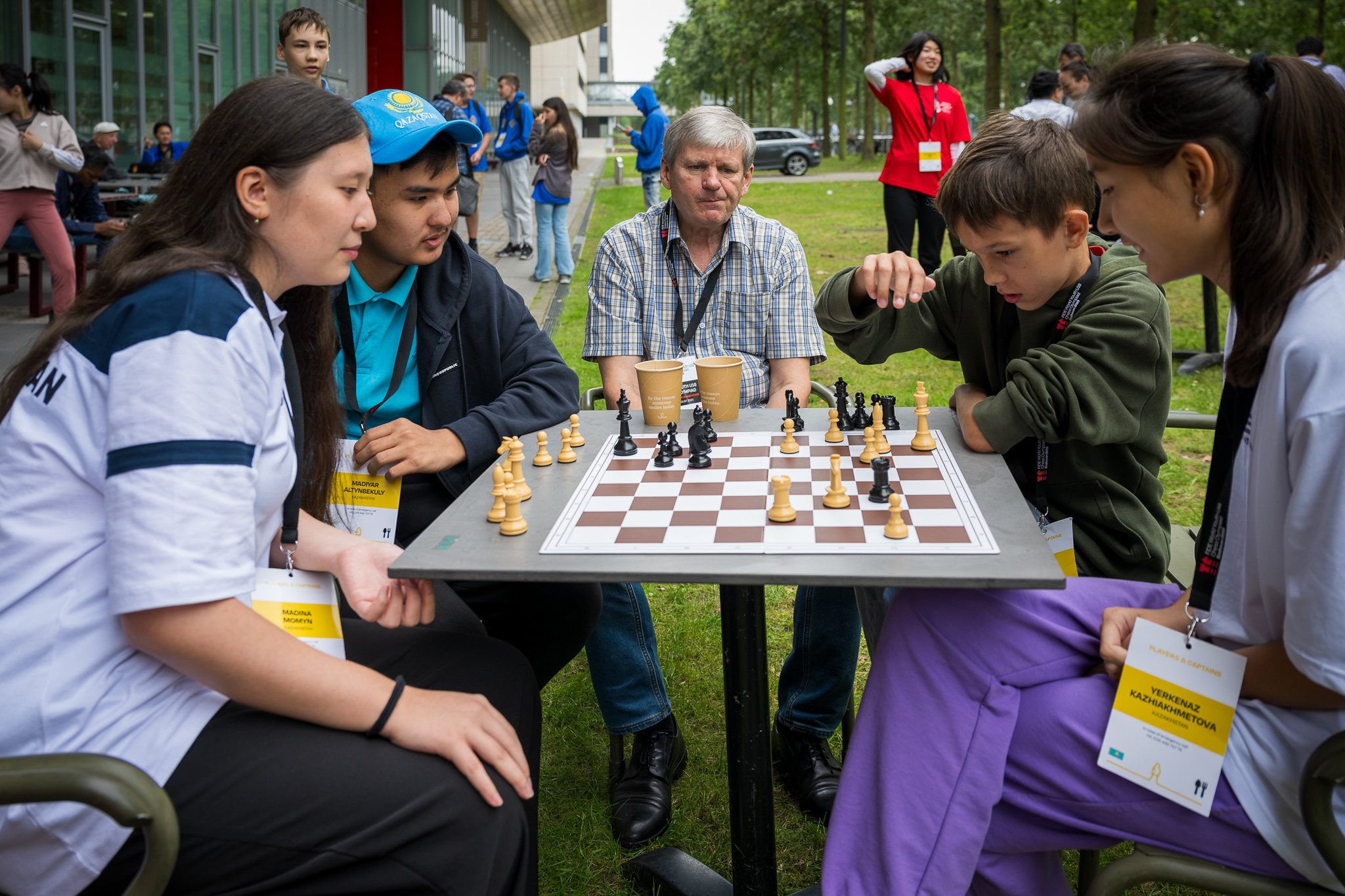Report by Michaël van Liempt
Today, two more rounds were on the schedule. That means a lot of hard work, both for the participants and for the reporters. But hard work is not the same as tedious work. On the contrary: as spectators, we’re getting a lot of value for our money.
Round 7
All eyes are on the leader, China, and especially on their star player Miaoyi Lu, who still had a perfect 100% score going into this round.
Miaoyi Lu – Nvard Hayrapetyan
1. e4 c5 2. Nf3 e6 3. g3 Nc6 4. Bg2 d5 5. exd5 exd5 6. d4 Bg4 7. O-O Nxd4 8. Qe1+ Ne6?!
The knight is awkwardly placed here. 8…Be7 would have been better, allowing Black to achieve a normal development after moves like 9. Nxd4 cxd4 10. Qe5 Nf6.
9. Ne5 Bf5 10. c4!
White seizes the opportunity and forcefully opens the center.
10… Nf6 11. cxd5 Nxd5 12. g4 Bxb1
This seems to win a tempo since White has to capture back. After
13. Rxb1 Be7
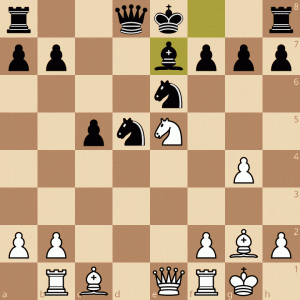
it seems like Black can finally castle. However, she doesn’t get the chance:
14. Qe4 Ndc7
After 14…Nec7, 15. Rd1 follows, winning material.
15. Qa4+ b5 16. Bc6+ Kf8 17. Qe4
Black’s castling is prevented, and the rook on a8 becomes trapped.
17…Rc8 18. Bb7 Bd6 19. Bxc8 Qxc8 20. Le3 f6
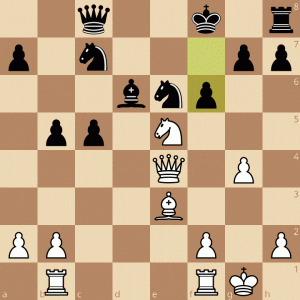
21. f4! Nxd8
After 21…fxe5 22. fxe5+ Black is in check. White regains the piece with interest and also obtains a dangerously advanced passed pawn.
22. Rbd1 Ne8 23. Kh1 Qe6 24. Bxc5 fxe5 25. fxe5+ Kg8 26. Bxd6 Nf7 27. Qd5 Qg6 28. Rf4 h5 29. Rdf1 Nf6 30. exf6 1-0
A textbook example of punishing opening mistakes.
With two draws on the top boards, China seemed to be heading for victory. Xiangrui Kong appeared to be holding well against Benik Agasarov, until it all went terribly wrong towards the end:
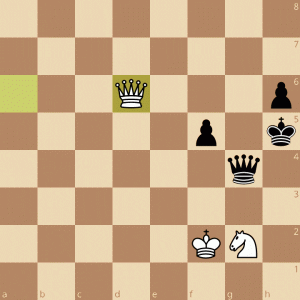
Black played the unfortunate 85…Qe4?? (something like 85…f4 ) and then 86.Nf4+ Kg4 87.Qg6+ delivered checkmate.
China suffered their first defeat of the tournament, experiencing their first loss of a game.
China is now at 13 match points after 7 rounds; Armenia follows with 11 points. They are joined in the battle for second place by Kazakhstan 1, who won 2½-1½ against Uzbekistan, and Turkey, who defeated Ukraine 3-1. Uzbek player Afruza Khamdamova, along with Miaoyi Lu, was the only player with a 100% score before this round, but she had to settle for a draw after 119 moves.
The game between Asronjon Omonov and Edgar Mamedov ended in a whimper for the white player.
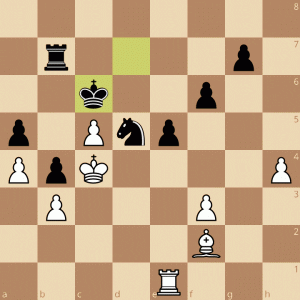
It might seem like there’s not much going on, but three moves later, White could shake hands:
56.h5?? Rcd8 57.Rf1?? Nf4
Suddenly, it’s Black who delivers checkmate! After
58.Bxf4 Rd1
he stopped the clock.
Eray Kilic took advantage of opponent Vladyslav Fishchuk’s overconfidence in the middle game, where Fishchuk moved his central pawns enthusiastically, leaving a few pieces hanging. Eray’s teammate Elifnaz Akat initially had less space after the opening and stood worse, until her opponent Roman Kovalskyi blundered in the following position:
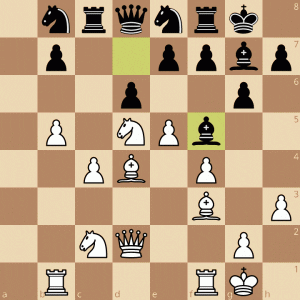
24.Nb6??
The wrong piece. After 24.Bb6 Qd7 25.Rbd1, White stands much better.
24…dxe5!
Suddenly, Black takes control.
25.Nxc8 exd4 26.Bxb7 Bxc8 27.Qd5
Black is winning, and on move 53, she delivered checkmate.
The first Dutch team secured a 2½-1½ victory against the well-performing Bangladesh. Yichen Han sacrificed a piece for two pawns but didn’t get the type of play he was looking for and eventually had to register a loss after defending for a long time. Arthur de Winter won a crucial pawn in the opening and gradually expanded his advantage into a win. In Prajit Sai Kumar’s game, the position swung back and forth, but in the end, White’s attack proved stronger than Black’s. Dana Verheij found herself in a difficult position in a queenless middlegame but managed to hold the fort and secured the crucial half point.
The third team, consisting of 75% of players from the U12 Dutch National Championship and playing higher than the second team for a change, had to concede to Canada 3. Noah Ritzerveld let a pawn slip, and although he tried to fight back, he eventually blundered his queen at the end to add to his woes. Wouter seemed lost, but his opponent pushed too aggressively, sacrificing a piece inaccurately. Wouter managed to escape with his extra material by moving his king out of the danger zone and converted his material advantage into a win. Oscar Zecha faced some misfortune in his game. In the position below, he played what seemed like a logical move against Ethan Su, which immediately led to a loss:
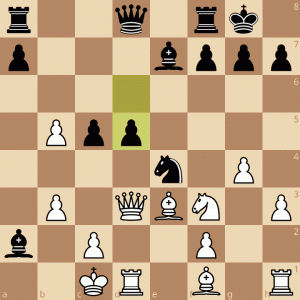
After 16.Qxe4 dxe4 17.Rxd8 Rfxd8 18.Nd2, White would have been in excellent shape, partly because the bishop on a2 will fall soon. Unfortunately, White played 16.Qxe5??, falling into Black’s trap with 16…c4!!. Suddenly, not only is 17…Ba3# a threat, but also 17…Qa5. White tried 17.Kb2, but after 17…Qa5 18.Bc1 c3+, he had to resign.
Fleur Westerhof fought valiantly for a draw but missed a tactic that cost her the queen.
The second team won 3½-½ against Australia 2. Kobe Smeets had the initiative in the endgame and converted it into a point. Roger Labruyère’s game (which, incidentally, was wrongly reported to Lichess) was a prolonged tug-of-war for the full point, with both players playing for a win and neither getting their way. Rhys Arnold had slightly less space in the opening but maintained prolonged pressure against a backward c-pawn. However, without initiating an attack, White was overwhelmed by a winning attack. Isafara Gergin’s game fluctuated in evaluation but eventually swung in her favor when her opponent willingly fell into a pin.
Netherlands 4 drew 2-2 against Hong Kong. Sascha Kurt sacrificed a queen in a Sicilian Dragon. The position remained tense for a while, but Black didn’t play precisely with the initiative, and after a queen trade, Black adeptly converted the advantage. Tommy Grooten adopted a Hedgehog setup. I recall his father once mentioning that he started playing the Hedgehog system himself (Elements of Chess Strategy). Tommy tried a counterattack, but his opponent pushed too hard and inaccurately sacrificed a piece. Tommy managed to maintain his extra material by maneuvering his king out of trouble and turned his material advantage into a win. Elysia Feng played an Accelerated Dragon that ended up in a double-rook endgame. The game continued until move 67 when no pieces remained on the board. Boyd Leenen had a more or less balanced endgame from an unusual opening, which eventually turned into a lifeless draw after White sacrificed the bishop pair for a position with uneven bishops.
Round 8
China secured victory in the Olympiad with one round to go. They defeated Hungary 4-0, a team that, on paper, wasn’t expected to lag behind China (with only a 49-point difference in average rating). This means that Miaoyi Lu still maintains a perfect score. Congratulations to the Chinese team, who with 15 match points and 27½ board points have an insurmountable lead: second-placed Turkey, after a 3½-½ victory against Kazakhstan, lags behind by 2 match points and 5 board points. Yagiz Kaan Erdogmus achieved a swift win after his opponent Daniyal Sapenov grabbed a dubious pawn on move 19:
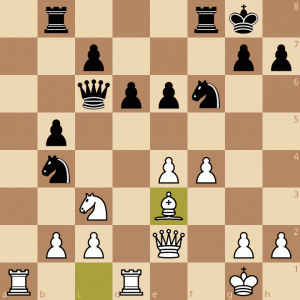
The game continued with the daring 19…Nxe4?! 20.Ba7 Rxf4 21.Rd4, and here Black made a serious mistake with 21…Nxc3?. White’s advantage grew considerably after 22.Qxe6+ Rf7 23.Bxb8 d5 24.Re1, and a few moves later, Black resigned.
Armenia and Azerbaijan drew 2-2. The game between Khagan Ahmad and Erik R. Gasparyan exemplifies what can go wrong for White in the Novosibirsk Variation of the Sveshnikov Sicilian:
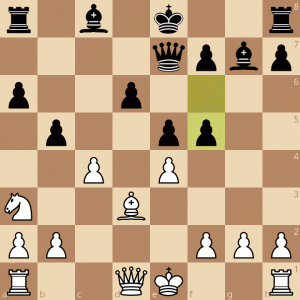
If White now calmly continues with 14.0-0, there would be no issues. However, he played the instructive mistake 14.cxb5?. Black responded to this flank action with the classic Sicilian counteraction in the center: 14…d5!. This is a key move in virtually every Sicilian, and this situation is no exception. After 15.bxa6 0-0 16.0-0 fxe4 17.Bb5 Rd8, Black gained a powerful block of central pawns. Black’s advantage remained unchallenged, and it was a matter of time until the Tetris block would start moving. Once that happened, White had no chance.
Netherlands 1 lost 2½-1½ against Austria. Yichen Han played a draw in a game that hasn’t strayed far from equality. In the endgame, Prajit Sai Kumar failed to neutralize Black’s passed pawn while trying to protect his own kingside pawns, leading to the pawn becoming an increasingly troublesome presence on the board. Dana Verheij didn’t find the strongest defense and succumbed to weaknesses around her king. Arthur de Winter won, although it required a fair share of luck:
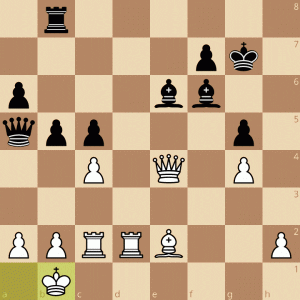
The position here is evaluated as 0.0 according to the engines. However, in the next five moves, the Lichess engine gives out 11 question marks. This once again demonstrates that positions with opposite-side castling and mutual attacks are incredibly difficult to play. Mistakes are always lurking in such razor-sharp positions, and finding the only correct move is often a challenging task.
33…Qa4?? (33…bxc4) 34.h4 Rh8?? (33…Bxc4) 35.b3?? (35.hxg5) Qb4 36.h5? (36.hxg5) a5 37.Qb7?? (37.Rd6) a4 38.Qf3?? (38.Qe4) bxc4 and Black gains a winning attack.
Netherlands 2 lost 1-3 against Slovenia. Kobe Smeets reached an endgame of rook + bishop versus rook + knight. Usually, RL (rook + bishop) is slightly stronger than RN (rook + knight), but the knight-player managed to block the pawns on the bishop’s color, and in addition, the knight-player had an active rook. This reduced White’s advantage, and the game ended in a draw. Roger Labruyère played a solid game in the Caro-Kann. After the queens were exchanged, he had slightly better chances due to his hanging pawns. However, White handled the endgame well and never seriously jeopardized Black. Despite capitalizing on a pin in the previous round to win material, Isafara Gergin overlooked the same opportunity in this game; the double-rook endgame was lost, and her opponent converted her winning chances without difficulty. In the end, Rhys Arnold thought he had a trick against Leon Skrbec, but he fell into a trick himself:
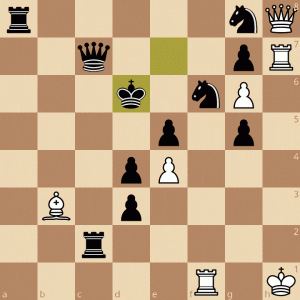
Rhys Arnold thought he had a trick at the end against Leon Skrbec, but he ended up being outwitted himself:
White had been attacking throughout the game, and the black king had just escaped danger. White played 45.Rxf6+ here, convinced that the g7 pawn was pinned. However, Black responded coolly with 45…gxf6! The queen cannot be taken due to 46…Ra1# mate! White resigned.
But what everyone had secretly been looking forward to was the real spectacle of round 8: Netherlands 3–Netherlands 4.
Noah Ritzerveld – Sascha Kurt 0-1
In an Icelandic variation of the Scandinavian Defense, Black obtained the better position. The situation with opposite-side castling was highly playable for Black, as they had control over the half-open g-file.
Tommy Grooten – Wouter Terlouw ½-½
White adopted his own Hedgehog system. This allowed Black to maintain prolonged spatial advantage, and towards the end of the game, Black could have played for a win, but a draw was probably sufficient to secure the match.
Oscar Zecha – Elysia Feng 1-0
In a Tarrasch variation of the Queen’s Gambit, Black obtained the isolated queen’s pawn, as is customary in this setup. For some incomprehensible reason, she left a knight unprotected in the middlegame, even though she had a slightly better position. A move later, she allowed a knight fork, resulting in further material loss.
Boyd Leenen – Fleur Westerhof 0-1
The opening setup was perfectly fine. Nothing was amiss. Only on move 12, White should have played a2-a3. Neglecting that, White’s position was swiftly swept away.
Standings:
After 8 rounds in the Olympiad, China secured victory with 15 points. Turkey is second with 13 points, followed by Armenia, Kazakhstan 1, and Austria with 12 points. Medals are out of reach for the Dutch teams. Netherlands 1 has 10 points and is in 10th place. Netherlands 3 has 8 points and is in 35th place; just behind is Netherlands 2 with 7 points, and Netherlands 4 is in 47th place with 6 points.
Tomorrow, there’s one more round to go.


